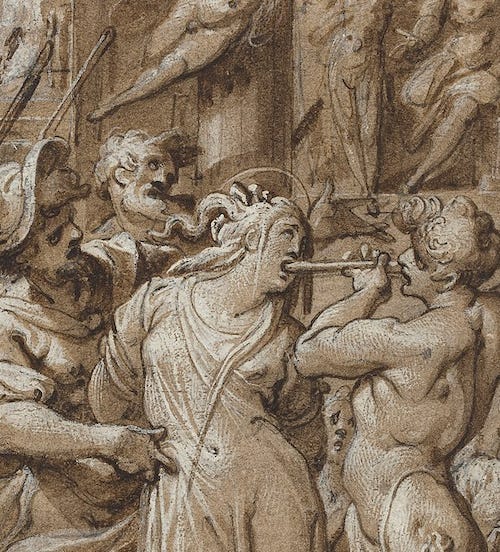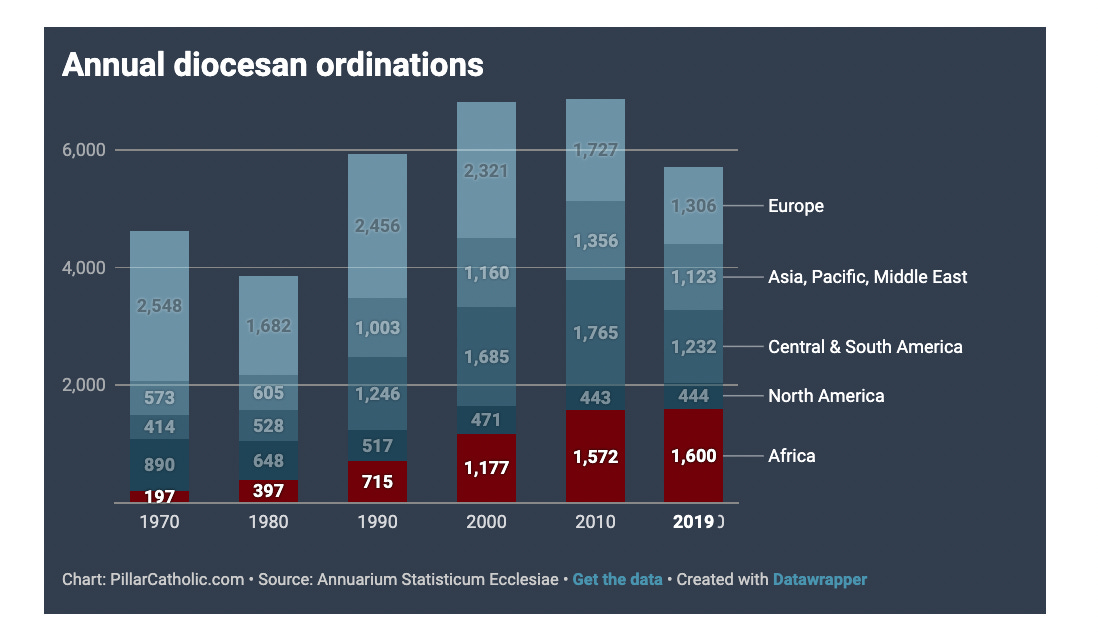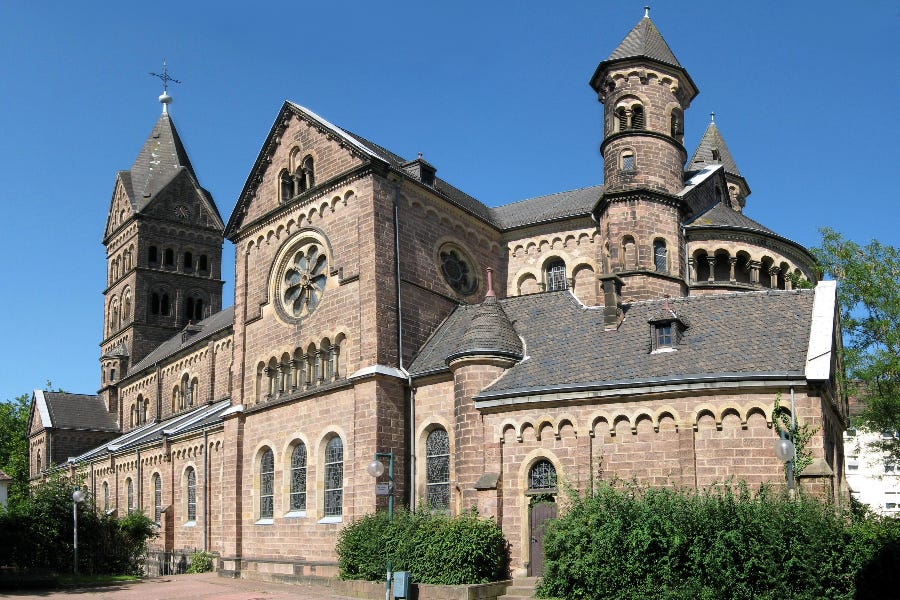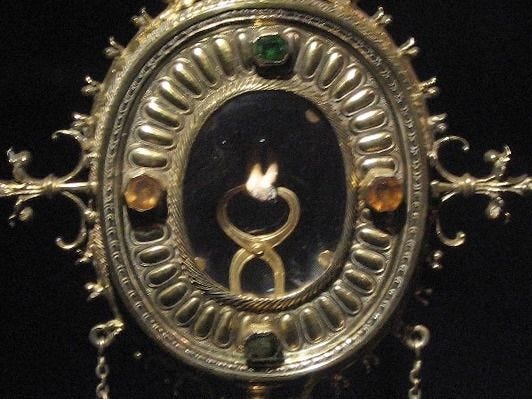
Hey everybody,
Thursday- in two days - is the feast of St. Apollonia, a third-century martyr who is the patron saint of dentists, those who need dental work, and - one hopes - those who fear going to the dentist.
Apollonia lived in Alexandria, Egypt, and, by many accounts was a deaconess — a woman appointed in the community to provide pastoral care to women, and possibly baptism to women catechumens.
In the year 249, there began a bloody persecution against Christians in Alexandria, spurred on by the soothsayers and prophets of local religions, and tolerated by the Roman authorities.
Apollonia was one of the Christians tortured and martyred during that persecution, she was eventually burned alive outside the city gates, after she refused to blaspheme Jesus Christ.
But popular legend says that before she was burned alive, her teeth were extracted, one by one. Indeed, reliquaries in several European cathedrals hold ancient teeth, long revered as the teeth of Apollonia.
Her bishop, Dionysius, recorded in a letter only that after she was seized, “repeated blows broke all her teeth.”
Still, in either case, Apollonia suffered for Jesus Christ, and was immediately revered by her community as a holy martyr.
"The blood of the martyrs is the seed of the Church," Tertullian said. So too with the teeth pulled or broken for Jesus Christ, I suppose.
St. Apollonia’s life and witness give glory to God. May she pray for us — and if you’re putting off a dentist appointment, well, ask her intercession, and make it today.
The news
The Ukrainian Greek Catholic Church announced Monday that it will no longer use the Julian calendar — the liturgical calendar used by the Russian Orthodox Church, and a handful of other Russian-influenced Orthodox Churches around the world.
We reported last month that there was a move among some Ukrainian Catholics and Orthodox believers to move away from the Julian calendar, and towards the liturgical calendar used by most Orthodox Christians, which is kind of a “revised Julian calendar,” which mostly aligns with the Gregorian calendar used by the West.
We didn't expect a change would come so soon, and we didn’t expect that the UGCC would lead the charge. But the Ukrainian Catholic Church decided in a synod last week that it would make the move.
Of course, this might seem to you like a bit of liturgical nerdery — and it is. But it’s not just liturgical nerdery. This change is a story about the way religion, culture, and global politics shape and influence each other.
We’ve told you before that it is impossible to understand the war in Ukraine without understanding its religious landscape — and that most Western media, Catholic and secular, isn’t giving that enough coverage, if any.
This calendar change is a good example. The calendar change is a look among Ukrainian believers, toward Rome and Constantinople, and away from Moscow. And it comes while many Ukrainians say that using the Julian calendar feels like conceding a part of the “Russkiy Mir” — the ideology by which Russia claims both a cultural and political primacy over Ukraine and its other neighbors.
So what’s new, practically speaking? Well, Ukrainian Catholics will begin celebrating a fixed liturgical cycle that resembles the Gregorian calendar, while keeping to the Paschal cycle kept by most Orthodox churches.
Ukrainians will begin Christmas on Dec. 25, the same day as Roman Catholics do, rather than on Jan. 7.
For now, the Ukrainians will celebrate Easter on the same date as do nearly all Orthodox Christians, Russian and Greek alike. But that could change — especially because Pope Francis and Greek Orthodox Patriarch Bartholomew I are trying to find a common date for the celebration of Easter.
📰
—
While we’re in Europe — European bishops and laity met in Prague this weekend for their synod on synodality continental assembly.
The session was expected to become the locus of considerable debate, among bishops with markedly different approaches to the synod.
“The goal of the discussion at the first synodal assembly in October 2023 should not be to succumb to the temptation to build some other church, but to seek answers to the question of how to realize the spirituality of synodality within the one Church of Christ, with its hierarchical structure,” Aleksander Bańka said Feb. 7.
Other delegates chimed in Tuesday, with the Nordic bishops emphasizing the “divine origin” of the Church.
Fr. Marco Pasinato, a priest of Finland, warned that “the temptation can be great to see the Church only as a structural phenomenon that can be changed at will.”
—
Pope Francis returned Sunday from a trip to the Democratic Republic of Congo and to South Sudan. We’ll bring you later this week a bit more on what the pope said during the trip, but for now, we have for you a conversation with Congolese journalist Antoine Roger Lokongo — who talked with us about what the pope’s visit seemed to mean to the people of the DRC.
He began with a really interesting perspective on what a speech itself means for many Congolese people:
In Congolese culture, as in other African cultures, the discourse of a chief is seen as having a kind of mystical power. That’s why a chief’s speech is always preceded by rituals and dance, because it is expected to bring life-changing effects.
It is in this light that you can understand the dancing procession before the proclamation of the Gospel in the Congolese Rite of Mass [also known as the Zaire Rite]. Also, before the pope’s speech to Congolese youth in a packed national stadium on Feb. 2, traditional dancing was performed to that effect, to the rhythm of drums and songs.
The Bongando people, my ethnic community, say that the words we utter incarnate our very being. Therefore, life can never exist without speech. Speech carries life. There is such a close relationship between speech and speaker that they are one, especially if that speaker is a world leader.
According to this worldview, a lie negates life; it betrays one’s being and affects the lives of those who hear it. It puts the whole community in danger because, as the Ubuntu philosophy expresses it, “I am because we are.”
It was easy for my ancestors to grasp the biblical and theological truth according to which when God utters a word it becomes a living creation. Jesus himself is the Word of God made flesh, whose word gives life and changes the world.
—
Meanwhile, during the papal visit, there was a lot of talk from some Western commentators about the importance of Pope Francis visiting “the peripheries.”
From an economic perspective, sub-Saharan Africa might be described that way. But for the Church, sub-Saharan Africa is not the periphery. It’s the center.
We’re sure about that, because Brendan Hodge ran the numbers. By Catholic population, Mass attendance, and priestly ordinations, sub-Saharan Africa is fast becoming the epicenter of Catholic life.
See what I mean?
If you want the full picture, check out this very thorough report on the Church in Africa, by the numbers.
📰
— A few more news items:
— Catholics in southern India have asked a court to intervene in negotiations to reopen a cathedral closed by police, after clashes over the liturgy in the Syro-Malabar Church. This is one of the biggest stories happening in global Catholicism right now, as a liturgical disagreement has become a riotous civil war, which has seen protestors block bishops from cathedrals and knock over altars, and seen police shut down both sides amid riots in the streets. Read about it.
— The Diocese of Knoxville, Tennessee, has asked the judge in an ongoing lawsuit to seal all documents pertaining to the diocesan review board, meetings of priests, and the Vos estis investigation taking place in the diocese. Those include diocesan documents, and those which might be subpoenaed from other sources, including the people who made the Vos estis complaints. Critics say the motion is an effort to silence whistleblowers, while the diocese says that leaked documents could prejudice a jury. Here’s the latest.
— By the way, if you’re not reading Starting Seven - a very short daily round-up of the latest Catholic news - you really should be. It’s an incredible resource. Here’s how to sign up:
Start your day with Starting Seven - a daily news roundup in your inbox.
—
Ed and I were invited last weekend to the University of Dallas, to join Jonathan Sanford, the university’s president, for a conversation about what it means to be a Catholic university.
It was a good conversation, and we’ll release it as a sponsored episode of The Pillar Podcast later this week. But if you like, you can watch it right here.
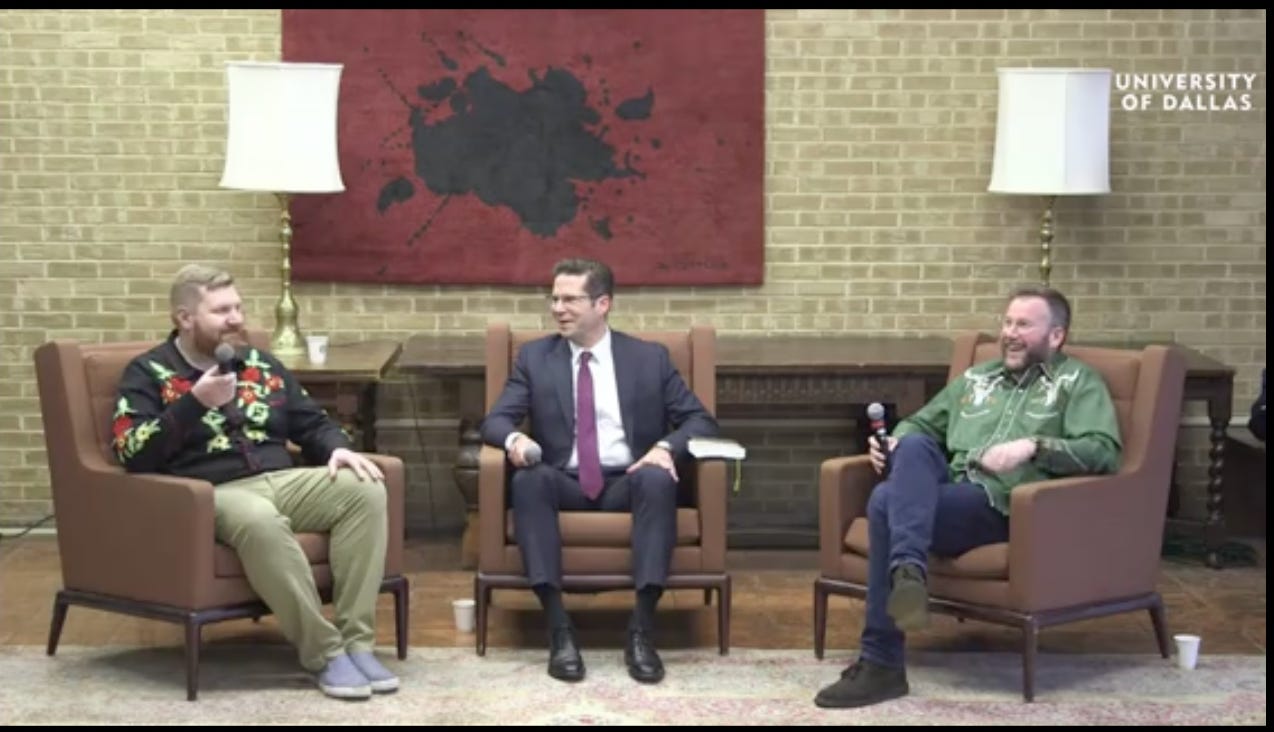
'Domain awareness gap'

The U.S. military on Saturday shot down the Chinese spy balloon that had slowly traversed the country last week, sending pictures and other kinds of data back to Beijing, presumably.
There’s now another Chinese balloon floating over Latin America and the Caribbean, and the Pentagon says that three other Chinese balloons have traveled across the U.S. in recent years.
The problem, the Pentagon says, is that the U.S. government had a “domain awareness gap” which prevented it from noticing those balloons.
As far as I can tell, a “domain awareness gap” is when you’re not looking for spy balloons. I guess that gap’s closed now.
Some people have speculated that the Chinese released the balloons as a test of American awareness, and to probe what the U.S. would do once it found a giant, helium-propelled spying apparatus in the sky.
But I’m not so sure.
I’ve learned this week that spy balloons can do things that satellites can’t do easily, like intercepting some kinds of communications signals, taking infrared pictures, and hovering for days over an intelligence target — unlike a satellite, which orbits predictably, and can only take pictures for a limited window of time.
The Chinese balloon shot down this week was even steerable — it had propellers, and presumably, a team of operators in China. They wouldn’t be able to steer it anywhere, of course, but within the parameters allowed by the wind, it would have some maneuverability.
The most interesting thing about the balloons to me is that many of them are no thicker than a birthday party balloon — they’re usually plastic or vinyl, not latex, but they’re not especially armored, because the hope is that they’ll avoid detection until they complete their mission — and at their high altitude, there’s not much to collide with either.
And the balloons don’t pop, really, which is what makes them a bit hard to take down.
The air pressure inside - they’re usually filled with helium - is not that much greater than the pressure outside. A puncture allows air to seep out slowly, but it doesn’t cause the kind of rupture you see if you pop a balloon tied to your wrist.
So if you want to shoot one down, your missile has to detonate at just the right moment, because piercing the balloon won’t do it.
After all, the Chinese spy balloon was HUGE:
China, by the way, is not the only country with a history of military ballooning.
In the 1940s and 1950s, the U.S. often flew balloons over the Soviet Union, and a number of countries used balloons during World War I.
But it was the French, believe it or not, who pioneered modern intelligence and military ballooning.
Napoleon even considered mounting a balloon-driven invasion of England. But Sophie Blanchard, who I have told you about before (!!!), put the kibosh on that plan, telling Le Petit Caporal that the winds would be too unpredictable.

In the American Civil War, Lincoln organized the Union Army Balloon Corps, which hovered over battlefields in the war’s early years, and helped direct artillery fire toward enemy locations. But by some accounts, balloonists were a weird lot, generals didn’t like working with them, and the balloon corps fell apart by 1863.
Military ballooning has been mostly out of fashion for a little while. But it's coming back — the 2023 U.S. Defense Department budget included $27.1 million on balloon projects, a big increase from the $3.8 million spent annually on balloons in recent years.
Get ready for the Balloon Wars, I guess.
—
This has nothing to do with balloons, but it's a video of otters and wolves on a game trail in Minnesota, and everyone likes watching stuff like that.
—
Finally, a little announcement. Our subscription system began this month having some technical difficulties, such as reclassifying or adjusting some subscribers’ accounts, for reasons that we can’t quite understand. We’ve been looking under the hood for the past few days, and trying to fix the system, but we’ll be contacting some of you this week and next to ask for your help resetting your subscription. We hate the inconvenience of this, and we are really working to fix it.
But if we do contact you, we’d be grateful if you’d help us out. Really, we’re sorry, and we’re looking to find better management systems. Thanks for your understanding.
(And if you want to become a paying subscriber to The Pillar, now’s a great time for it!)
We’ll have more news reporting for you this week. Stay tuned.
Please be assured of our prayers, and please pray for us. We need it.
May St. Apollonia pray for you, and, really, if you’re putting it off, call the dentist.
Yours in Christ,
JD Flynn
editor-in-chief
The Pillar

